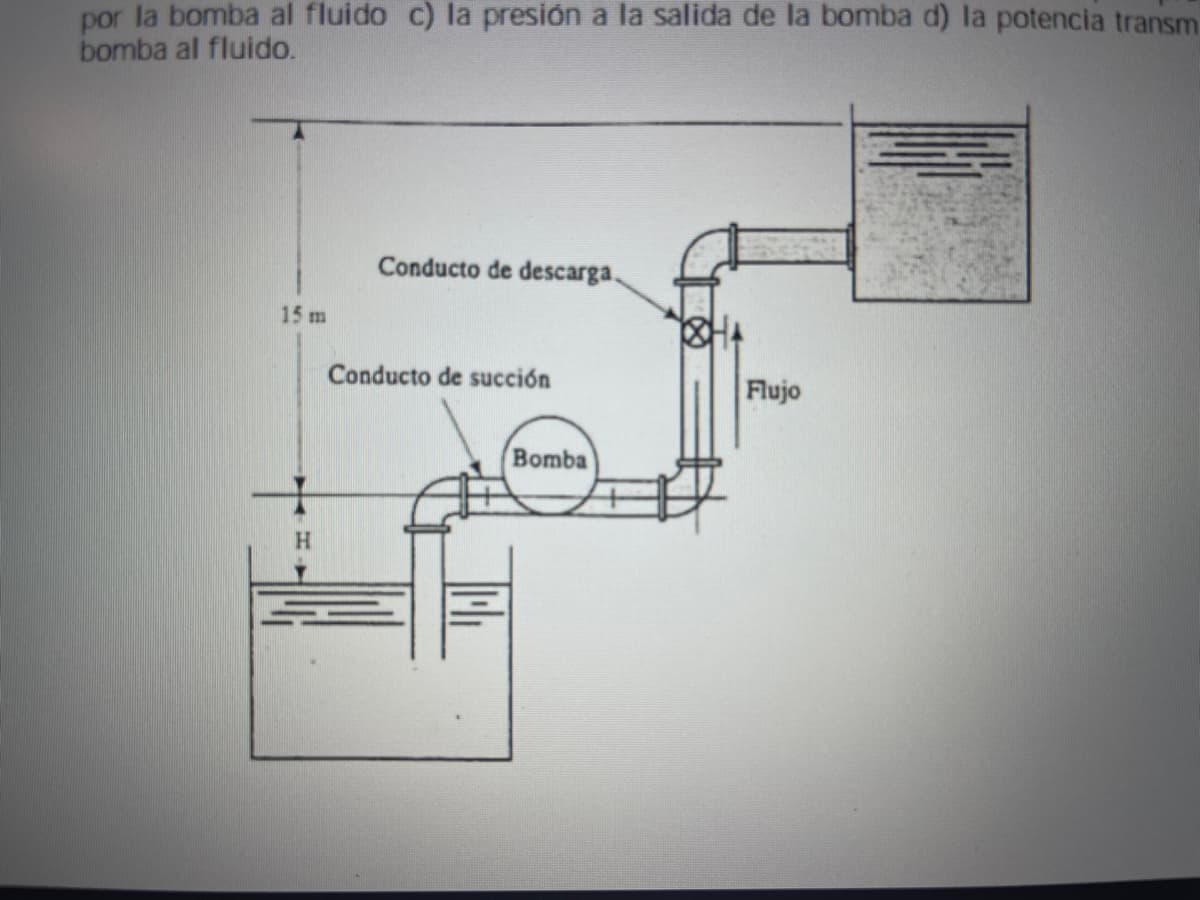In a cavitation system, it usually occurs in the hydraulic element called the pump. In the presented system, it is desired to determine the maximum height H, for which there is no cavitation, and with this condition, determine the different parameters. For this, it is known that the system moves water at a flow rate of 0.056m³/s at a temperature of 40°C. The energy loss between the suction pipe inlet and the pump is 2.0 N-m/N and between the pump outlet and the upper vessel is 3.8 N-m/N. Both ducts are 6" 40-gauge steel. The vapor pressure of water at 40°C is 0.078 kgf/cm² (abs). The specific weight of water is 9.76 kN/m³. Determine a) The height H for the limit condition of no cavitation of the pump b) the energy per unit of weight provided by the pump to the fluid c) the pressure at the pump outlet d) the power transmitted by the pump to the fluid hydraulic power
In a cavitation system, it usually occurs in the hydraulic element called the pump. In the presented system, it is desired to determine the maximum height H, for which there is no cavitation, and with this condition, determine the different parameters. For this, it is known that the system moves water at a flow rate of 0.056m³/s at a temperature of 40°C. The energy loss between the suction pipe inlet and the pump is 2.0 N-m/N and between the pump outlet and the upper vessel is 3.8 N-m/N. Both ducts are 6" 40-gauge steel. The vapor pressure of water at 40°C is 0.078 kgf/cm² (abs). The specific weight of water is 9.76 kN/m³. Determine a) The height H for the limit condition of no cavitation of the pump b) the energy per unit of weight provided by the pump to the fluid c) the pressure at the pump outlet d) the power transmitted by the pump to the fluid hydraulic power
Automotive Technology: A Systems Approach (MindTap Course List)
6th Edition
ISBN:9781133612315
Author:Jack Erjavec, Rob Thompson
Publisher:Jack Erjavec, Rob Thompson
Chapter44: Four- And All-wheel Drive
Section: Chapter Questions
Problem 7RQ: When the plates of a viscous coupling (clutch) rotate at different speeds, the plates ____________...
Related questions
Question
In a cavitation system, it usually occurs in the hydraulic element called the pump. In the presented system, it is desired to determine the maximum height H, for which there is no cavitation, and with this condition, determine the different parameters. For this, it is known that the system moves water at a flow rate of 0.056m³/s at a temperature of 40°C. The energy loss between the suction pipe inlet and the pump is 2.0 N-m/N and between the pump outlet and the upper vessel is 3.8 N-m/N. Both ducts are 6" 40-gauge steel. The vapor pressure of water at 40°C is 0.078 kgf/cm² (abs). The specific weight of water is 9.76 kN/m³. Determine a) The height H for the limit condition of no cavitation of the pump b) the energy per unit of weight provided by the pump to the fluid c) the pressure at the pump outlet d) the power transmitted by the pump to the fluid hydraulic power

Transcribed Image Text:por la bomba al fluido c) la presión a la salida de la bomba d) la potencia transm
bomba al fluido.
15 m
Conducto de descarga.
Conducto de succión
Bomba
Flujo
Expert Solution
This question has been solved!
Explore an expertly crafted, step-by-step solution for a thorough understanding of key concepts.
Step by step
Solved in 2 steps with 4 images

Knowledge Booster
Learn more about
Need a deep-dive on the concept behind this application? Look no further. Learn more about this topic, mechanical-engineering and related others by exploring similar questions and additional content below.Recommended textbooks for you

Automotive Technology: A Systems Approach (MindTa…
Mechanical Engineering
ISBN:
9781133612315
Author:
Jack Erjavec, Rob Thompson
Publisher:
Cengage Learning

Automotive Technology: A Systems Approach (MindTa…
Mechanical Engineering
ISBN:
9781133612315
Author:
Jack Erjavec, Rob Thompson
Publisher:
Cengage Learning